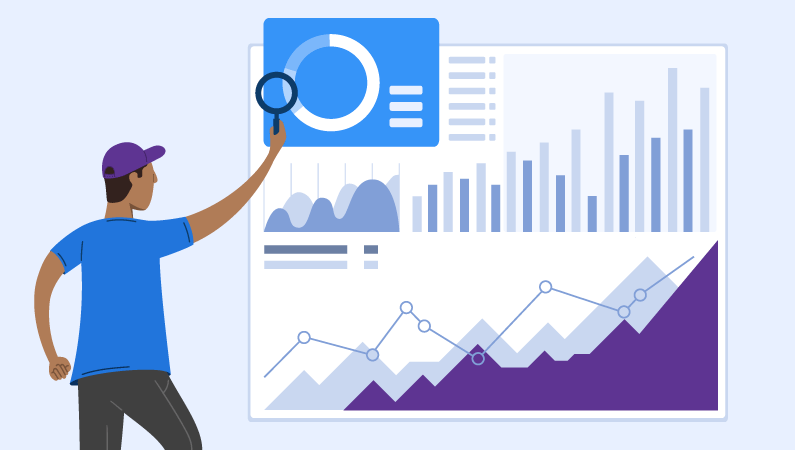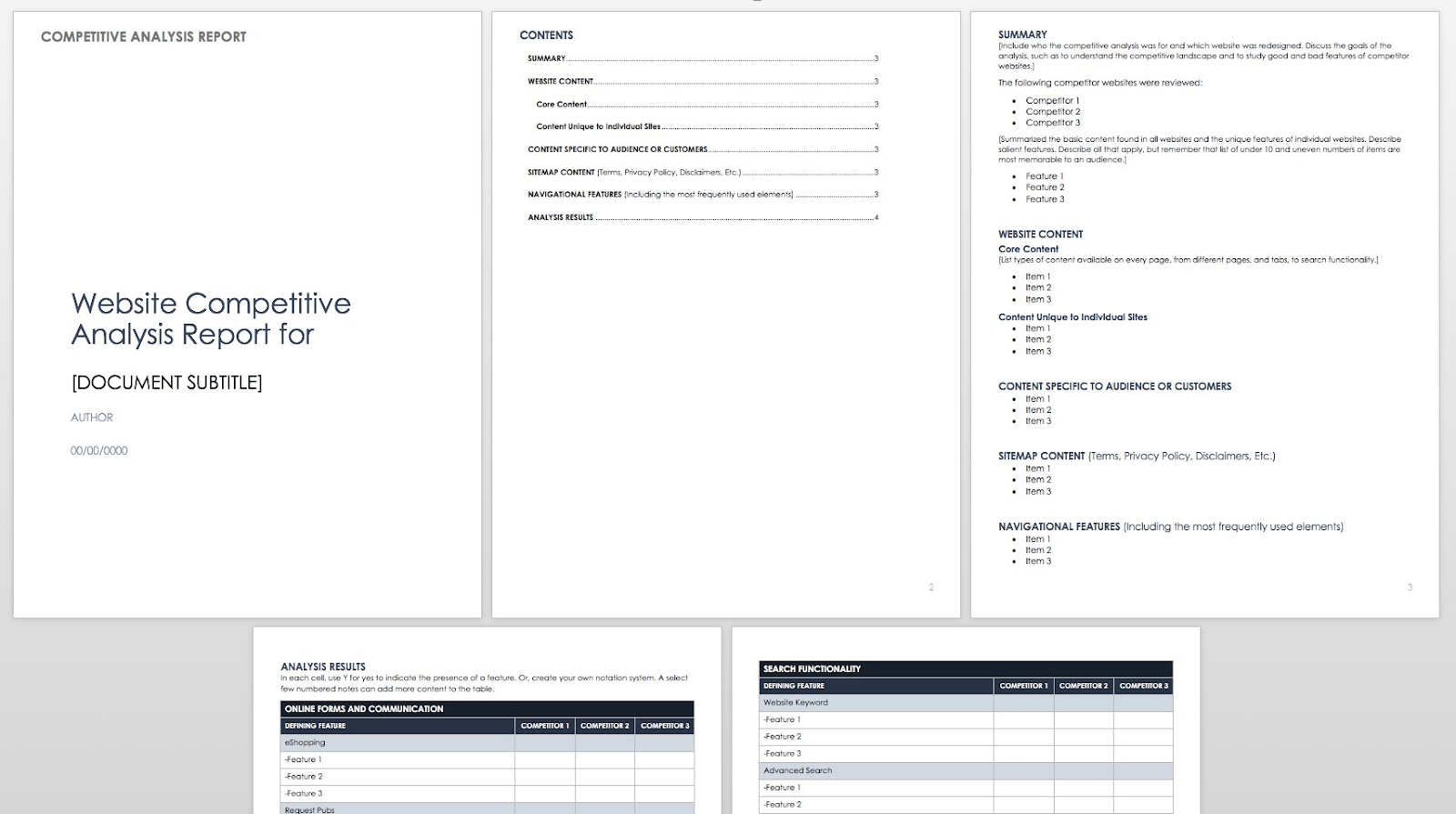

What is a competitive analysis and how to conduct one (plus free templates)
When it comes to building a thriving and sustainable business over the long term, research is one of the most important paths to success.
It isn’t flashy, but every successful business is built on a thorough understanding of the market—what customers need and what competitors are doing to fill that need. Every business decision is made based on that foundational and evolving market research.
That’s where competitive analysis comes into play, and that’s why learning what is a competitive analysis and understanding the insights it can offer your business is table stakes for entrepreneurs.
What is a competitive analysis?
Let’s start at the beginning. Despite the name, competitive analysis isn’t a complicated concept or process. Simply put, it’s a process of taking a look at everything your competitors do and the results those efforts create for them. That includes things like:
- Marketing channels
- Pricing packages
- Product features
- Brand positioning
- Messaging
During a competitive analysis, you gather information about those aspects (and others!) of your primary competitors’ business—then look for weaknesses, insights, and opportunities you can capitalize on to outcompete those brands.
The benefits of analyzing your competition
You can never really be too informed about your market, your customers, and other competitors. The more information you have, the better decisions you can make—so there’s always a benefit to learning how to do a competitive analysis to better understand the market you compete in.
That said, competitive analysis is one exercise that can have an outsized impact on your strategy and the results it drives. Some of the chief benefits of analyzing your competition include:
- A better understanding of where your company fits into the larger market
- The ability to identify competitor weaknesses and potential opportunities
- The chance to get a sense of what’s working for competitors (in terms of pricing, marketing channels, messaging, and other factors) and use it to inform your own strategy
- Additional context you can use to work through specific business challenges you face
How to do a competitive analysis: 5 steps to success
Now that we’re on the same page about what a competitive analysis is and the benefits of conducting one, let’s talk about how to go about it. For our purposes today, we’re breaking down how to do a competitive analysis into five key steps.
Step 1: Set your intention
Pausing to consider your goals is always a good first step for just about every business initiative, and a competitive analysis is no exception. Start by asking why you’re conducting an analysis—what are you hoping to learn from your competitors and your market?
For example, if you’re launching a new brand and market research is new to you, you probably need a comprehensive and holistic picture of the current competitive landscape so you can figure out where your brand will fit in.
If you’ve already launched and you’re struggling with a specific business challenge (like choosing the right pricing strategy or finding a marketing channel that clicks), the information you look for from competitors will be narrower.
That’s why it’s important to know what you’re hoping to get out of the analysis before you dive into it.
Step 2: List out top competitors to analyze
Once you know the information you’re looking for, write down the top competitors you’ll analyze. Don’t go crazy here (or you may end up with something resembling analysis paralysis)—anywhere from 5-10 competitors will offer plenty of data to analyze.
If your intention from Step 1 was to find out specific aspects of competitor businesses, try to choose brands who are getting it right. For example, if you’re looking for information on the type of content that resonates with customers in your market, choose competitors whose blogs, social media, and search rankings are thriving.
Note down each competitor in a spreadsheet or competitive analysis template (you can find those below!)
Step 3: Gather information
Gathering information about your competitor list is far and away the most intensive step in the competitive analysis process.
To start, get hands-on by interacting directly (if you can) with your competitor’s content, product, user experience, and customer service.
- Sign up for your competitor’s service or purchase their product
- Subscribe to their email list, read their content, and follow their social media accounts
- Try to find a specific piece of information on their website
- Read customer reviews and testimonials, particularly on third-party websites (like Yelp, G2Crowd, and app stores)
Interacting directly with a competing brand will help you get into the mindset of your customers and make it easier to understand the competitor from the customer’s point of view in a way that data alone can’t do.
You can also draw on several tools to find a more objective and comprehensive view of where your competitors have seen success and where they haven’t.
- Alexa can help you audit competing websites including their traffic sources and other websites linking to them.
- BuzzSumo shows you content that resonates with your target audience, particularly across social media.
- Whatrunswhere can show you where competitors are advertising across the web, plus what their ads look like and how they perform.
- For ecommerce, Prisync keeps you informed on competitor prices and stock availability.
- Pi Datametrics gives you a comprehensive look at the entire competitive landscape in your industry.
Step 4: Identify strengths, weaknesses, opportunities, and threats
Now that you have a big pile of information about your top competitors, it’s time to put it to work by conducting a SWOT analysis. For each competitor, lay out all of the information you’ve gathered, categorizing it as a strength, weakness, opportunity, or threat. A useful SWOT analysis means taking an honest look at your own strengths and weaknesses, too.
From there, it’s all about recognizing where there are gaps between your business and your competitors.
Do they have a weakness where you have strength? How can you emphasize that to customers? Does it enable you to better serve a particular segment of customers? Do you have a weakness where your competitors are strong? How can you close that gap?
Identifying opportunities you can capitalize on to better compete and grab a larger or more engaged portion of the market ensures your competitive analysis yields actionable next steps to do something with all the information you gather.
Step 5: Act
Speaking of actually doing something, that’s where a lot of businesses fall off. A competitive analysis isn’t worth much if you don’t use your learnings to build a better competitive position for your business.
If you learn that several of your competitors have seen success with a particular marketing channel, take the next step to experiment with it yourself. If you find that none of your competitors are serving a particular niche within the market, make it your job to speak to and serve that segment.
Whatever it is, put your learnings to work for your business and you can build a powerful competitive advantage.
3 competitive analysis templates to get you started
When you’re dealing with a lot of information and data points, it’s easy to get overwhelmed — even for the most experience spreadsheet readers among us. That’s why a competitive analysis template can be a great option to help guide your research and keep everything organized and useful.
Here are three of our top picks for competitive analysis templates.
- For a comprehensive competitive analysis: Aha!’s template

- For web and content-focused competitive analysis: Smartsheet’s template

- For a competitive analysis for ecommerce businesses: Shopify’s template

What is a competitive analysis: Let your competitors inform your strategy
Focusing on your business is important, especially when you’re just getting started—but every entrepreneur needs to pick their head up from time to time to see what competitors are doing and where they fit into the broader market. That’s where learning how to do a competitive analysis comes in.
Making a regular practice of auditing both your own strengths and weaknesses and those of your competitors means you’ll have an all-around better strategy and increased likelihood of success. That’s something we can all get behind.
*While subscribed to Wave’s Pro Plan, get 2.9% + $0 (Visa, Mastercard, Discover) and 3.4% + $0 (Amex) per transaction for unlimited transactions during the offer period. After the offer ends: over 10 transactions per month at 2.9% + $0.60 (Visa, Mastercard, Discover) and 3.4% + $0.60 (Amex) per transaction. Discover processing is only available to US customers. See full terms and conditions.
See Terms of Service for more information.
The information and tips shared on this blog are meant to be used as learning and personal development tools as you launch, run and grow your business. While a good place to start, these articles should not take the place of personalized advice from professionals. As our lawyers would say: “All content on Wave’s blog is intended for informational purposes only. It should not be considered legal or financial advice.” Additionally, Wave is the legal copyright holder of all materials on the blog, and others cannot re-use or publish it without our written consent.










